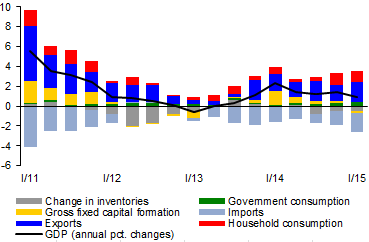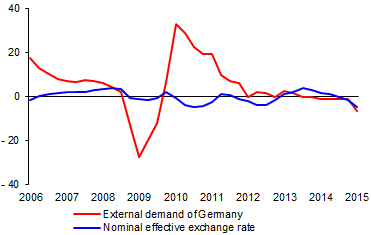The German economy and the dollar-euro exchange rate
The German economy has long been one of the biggest exporters in the world. It currently ranks third behind China and the USA and has trade surpluses with all its major trading partners except China;1 its current account surplus stands at around 7% of GDP. This confirms Germany’s exclusive position as the economic engine of the euro area,2 i.e. its essential role in world trade. However, the growth rate of the German economy has been falling slightly over the last two years, owing among other things to a decreasing positive contribution of net exports compared to previous periods and negative contributions of change in inventories (see Chart 1). This box aims to clarify why Germany has not recorded an upswing in GDP growth recently despite last year’s marked depreciation of the euro against most other world currencies, which – according to economic intuition – should have stimulated the export-oriented German economy.
Chart 1 (BOX) Structure of GDP in Germany
A decreasing contribution of net exports and a negative contribution of inventories are weakening the growth of the German economy
(annual percentage changes; contributions in percentage points; seasonally adjusted; source: Datastream, CNB calculation)

The first set of reasons pertains to the rate of German potential GDP growth, which, according to several different sources, is estimated at around 1.2%.3 Solely from this perspective, the current economic growth rates, which are above this level, should be regarded as satisfactory. The factors reducing the potential output of the German economy include a gradually fading effect of labour market reforms (Hartz I–IV), the introduction of a national minimum wage, higher energy prices (the switch from nuclear energy to renewable sources) and approved earlier retirement ages.4
The second set of reasons is connected with a lower sensitivity of the German economy to exchange rate movements. Calculations by the European Commission5 reveal that Germany has a markedly lower sensitivity of exports to the exchange rate than, for example, France or Italy (see Chart 2), so it is not surprising that the weakening of the euro is helping Germany to a smaller extent than other large euro area economies. The lower sensitivity of exports to exchange rate movements is due among other things to the structure of German exports, which is geared more towards capital goods (including a higher share of investment projects), where the price competitiveness factor is less important, and to a high proportion of euro-denominated export contracts.6
Chart 2 (BOX) Export sensitivity to exchange rate changes and export structure of selected euro area countries
The German economy is one of the least sensitive economies to exchange rate movements
(percentages, source: European Commission)

Note: Elasticity expresses the sensitivity of exports to a 1% change in the euro-dollar exchange rate.
Furthermore, a substantial slowdown and subsequent decline in external demand for German exports together with the weakening of the effective euro exchange rate has been observed recently (see Chart 3).7 The low elasticity of German exports to exchange rate movements suggests that the weakening is insufficient from the point of view of Germany’s growth performance to offset the unfavourable developments in the external environment, in particular the gradually falling growth rate of the Chinese economy and the plunge in Russian imports.
Chart 3 (BOX) Effective exchange rate and external demand of Germany
External demand for German exports has been weakening in parallel with the weakening of the exchange rate
(annual percentage changes; source: BIS, Datastream, OECD, CNB calculation)

Note: External demand is defined as the weighted average of the total imports of Germany's 22 largest trading partners in euro. NEER 27 – index of the nominal effective exchange rate of the euro for Germany's 27 main trading partners; growth represents.
However, the forecasts for the German economy (see Chart 4) show that its growth rate should again approach 2%, which is also good news for the countries for which Germany is an important trading partner. The causes can be divided into internal ones (growth in wages and employment, expansionary fiscal policy, persisting accommodative monetary conditions, higher creation of capital goods and lower energy prices for households and corporations) and external ones (solid expected growth of the world economy, a recovery in the core euro area countries, lower dollar prices of oil and other commodities and an unwinding of the effect on economic growth of the drop in exports to Russia).
Chart 4 (BOX) GDP forecasts for German economy
The growth forecasts for the German economy are quite optimistic
(annual percentage changes; source: CF, IMF, OECD, DBB)

1 Germany continues to record goods trade deficits with Japan and Russia, and in Europe mainly with Norway and the Netherlands and also with the Czech Republic.
2 Germany’s per capita GDP is 18 percentage points higher than the euro area average, and its economy accounts for almost 29% of the euro area economy (measured in euro, 2014 data).
3 Deutsche Bundesbank, OECD, The Economist (currently 1.1 percentage points, accelerating to 1.6 percentage points in 2017).
4 The current performance of the German economy is also being affected by recent strong fiscal consolidation.
5 Quarterly Report on the Euro Area (2014), Vol. 13, No. 3.
6 According to ECB (2010), the share of Germany’s euro-denominated extra-euro area exports reached almost 74% in 2009, see ECB (2010): International Role of the Euro, July.
7 This was due to a sizeable decline in the combined imports of China and Russia and to a smaller extent to a year-on-year decrease in imports to Japan, the Netherlands and Sweden.
